As the Salton Sea Shrinks, Agriculture’s Legacy Turns to Dust
This project was originally published in Civil Eats with support from our 2022 Data Fellowship.
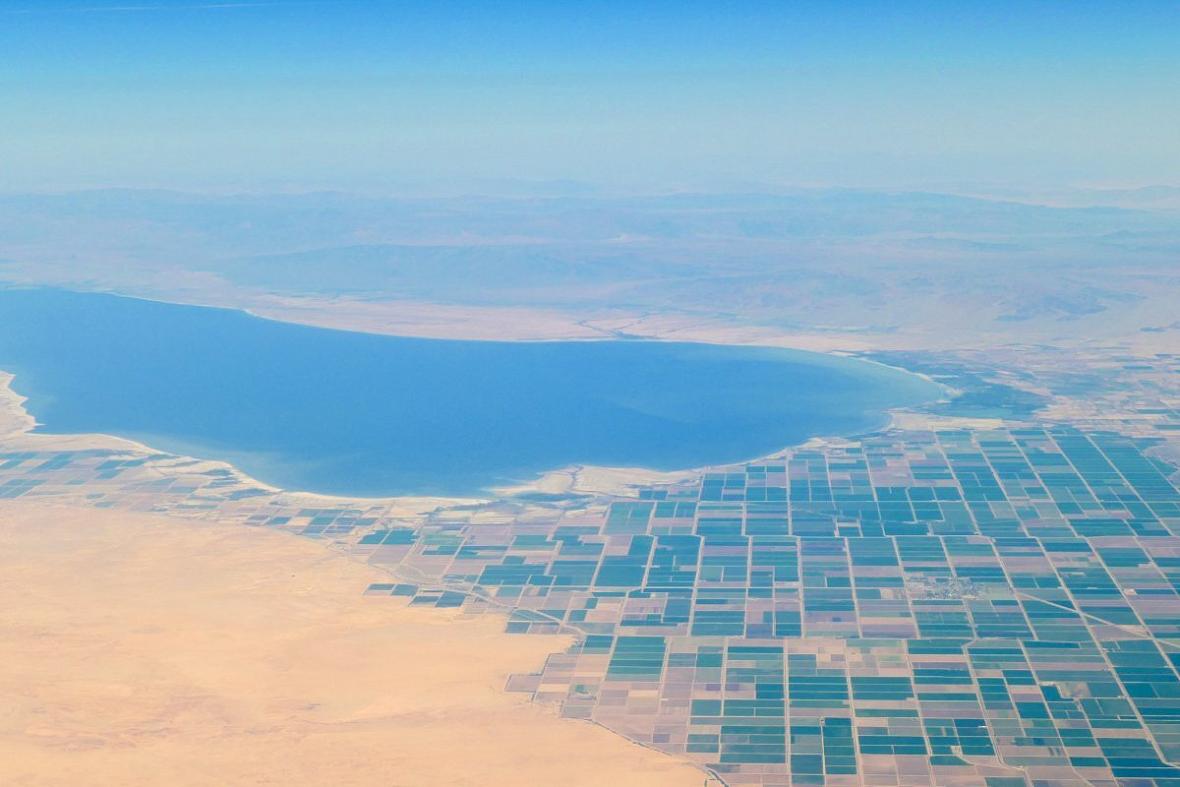
Salton Sea area of Imperial County, California, with farmland and the farm towns of Niland, Brawley, Westmorland, and others.
Photo credit: Raquel Lonas, Getty Images
Ana Rosa Villegas López points to the scattered images of her son on the walls of the Mecca Public Library in Southern California. In one, he stares straight at the camera, his sleeplessness etched into the dark circles under his eyes. The walls are covered with photos of children playing on a small square of artificial turf, dust-coated door mats, and the children’s inflamed, rashy arms, runny noses, inhalers, and humidifiers.
Building on findings from a recent study documenting the health impacts of poor air quality around the Salton Sea, California’s largest inland lake, López was one of 15 mothers who subsequently agreed to photograph their children and their environments. Three-quarters of the 36 caregivers in the study identified as Hispanic or Latino, and 24 percent identified as Purepecha, an Indigenous group from the Mexican state of Michoacan. Over half of them are farmworkers, as is common in the small, unincorporated communities that surround the sea.
On bad air quality days, López keeps her 8-year-old son and 4-year-old daughter inside to protect them from a cascade of symptoms that she says worsen with outdoor exposure, including congestion, skin allergies, and shallow, labored breathing that makes sleep elusive. A 2019 survey found that 22 percent of children have asthma in the region, almost three times the national rate of 8.3 percent.
“We watched as fish died by the millions and dozens of bird species disappeared. I always wondered, ‘What about us?’ We have been ignored.”
“The park in Salton City is covered in dust,” explains Nancy Del Castillo, one of the promotoras, or community health workers, who recruited caregivers to take pictures of their children. “It’s an undignified life,” she said at a recent event at the Mecca Library designed to share the findings to the community.
López’s family moved to Salton City from Arizona in 2018 when her then-husband got a job working in greenhouses in the Imperial Valley, south of the sea. Imperial Valley grows an estimated two-thirds of the country’s winter vegetables, as well as alfalfa for animal feed—but cattle has remained the No. 1 commodity for the last 64 years. Date palm plantations and orchards cover the eastern Coachella Valley to the north. Agricultural runoff from both valleys is the primary input into the Salton Sea, and with that runoff comes pesticides and nutrients such as phosphorous and nitrogen.
The Salton Sea is a complicated, dynamic ecosystem on the decline. At 240 feet below sea level, it has filled with water and dried many times over the centuries. In 1905, Colorado River floodwaters breached an irrigation canal and filled the depression with water. Since then, the sea has served as the dumping ground for decades of pollution from farming as well as legacy bomb-testing material.
In 2002, U.S. Geological Survey conducted sediment sampling from 73 locations and concluded that “the agricultural runoff that keeps the sea alive is loaded with salts, pesticides, selenium, and other metals.”
But a drought and reduced agricultural runoff have helped to shrink the shallow sea in the last two decades. Over that time, only a handful of smaller-scale research projects have attempted to document current sediment contaminants on what is now almost 20,000 acres of exposed playa that is adding dust to the region’s already poor air quality.
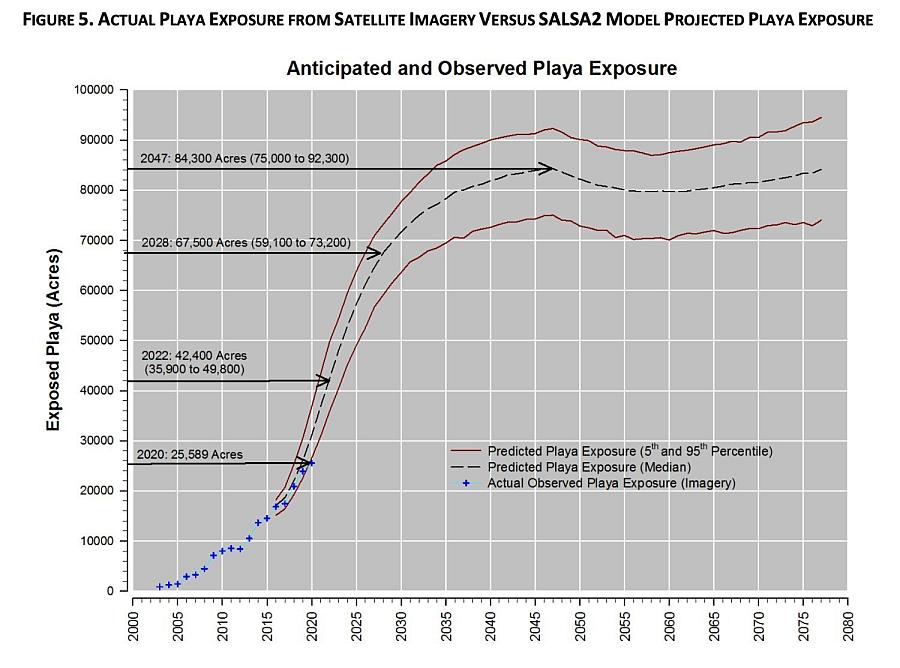
Chart source: The June 2022 Salton Sea Emissions Monitoring Program report by Formation Environmental for the Imperial Irrigation District.
The air quality in the Salton Sea region is among the worst in the nation. Imperial Valley routinely gets a failing grade for particulate matter and ozone from the American Lung Association’s annual State of the Air report. Imperial Valley has already been out of compliance with national air quality standards since 2014—due to a host of factors, including the Salton Sea, industrial farming in a desert, a well-trafficked border crossing, and factory emissions from Mexicali.
Imperial County residents were exposed to over 1,200 pounds of pesticides—via the air, water, and on the plants themselves—per square mile from 2017-2019. That exposure rate is over 90 percent higher than the rest of California. On top of that, the region is the hottest in the state—with over 117 days over 100 degrees, according to a 2022 Hazardous Heat report.
Farmers around the Salton Sea have worked to use water more efficiently and reduce field burning. But they also use intensive, conventional practices that rely on chemical inputs. And there is little if any conversation about changing those practices for the good of the Salton Sea or the area’s residents.
In the last few years, the long-neglected region has been dubbed Lithium Valley as it has received unprecedented attention due to its precious lithium reserves needed to fuel the state’s clean energy economy. But residents, scientists, and public health advocates worry that this new gold rush will further an extractive dynamic without adequately addressing community health. And new science about the connection between water pollution and air quality suggests more investment is needed.
Health Impacts a Growing Cause for Concern
Like most of the roughly 100,000 residents who live within 10 miles of the sea, López describes the environment as “toxic.” Experts have identified layers of environmental insults in the region—including sulfuric odors, arsenic and selenium, dust storms, airborne pesticide residue, and smoke from agricultural burning—which are all possible contributors to the children’s chronic health conditions, including respiratory illnesses such as asthma, bronchitis, and pneumonia, as well as chronic nosebleeds. Yet little research has focused on the cumulative public health impacts.
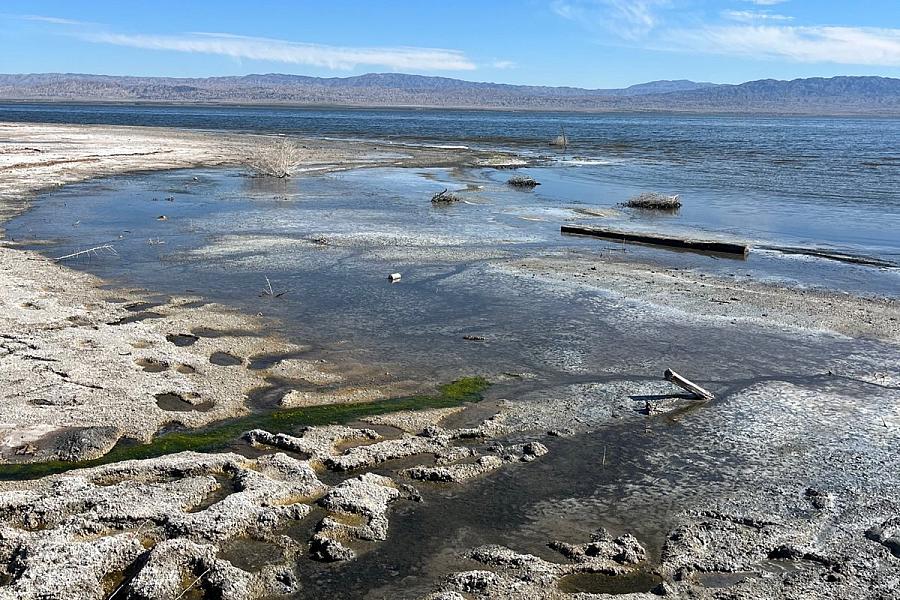
The shore of the Salton Sea.
(Photo credit: Virginia Gewin)
Sandra Ramirez, a community advocate and former farmworker who picked grapes and lemons in Coachella Valley between 1995 and 2002, attended the presentation in Mecca. “We watched as fish died by the millions and dozens of bird species disappeared,” she said afterward. “I always wondered, ‘What about us?’ We have been ignored.”
Over the last 10 years, the state’s natural resource, water, and wildlife agencies crafted the Salton Sea Management Program (SSMP) to “improve air quality and provide critical environmental habitat.” But the effort is woefully behind schedule. The goal is to create wetland wildlife habitat and plant vegetation to suppress dust on 30,000 of the 60,000 acres expected to be exposed by 2028. As of March 2023, only 290 had been completed.
“The community’s public health issues have not been addressed, regardless of the amount of funding being allocated for the past two to three decades.”
The state of California has committed $583 million to the 10-year SSMP. But separate state funding designated to address the human impacts of air pollution in the region more directly is only a fraction of that number. Under Assembly Bill 617, the California Air Resources Board established the Community Air Protection Program to address and reduce air pollution health impacts in environmental justice communities. To date, however, only roughly $30 million of the total AB617 funding has gone to Imperial County, which currently has two of the state’s 19 designated communities—one was named earlier this year. And AB617’s ability to improve air quality has come under scrutiny.
Yet politicians claim that residents’ health concerns are front and center. “Lithium Valley will serve as a model for how we can protect our community’s health while we advance these [mining] objectives,” Representative Raul Ruiz (D-California) said at a March press conference.
Lillian Garcia, a Coachella Valley-based advocate with United for Justice Inc., bristles at that characterization. “The community’s public health issues have not been addressed, regardless of the amount of funding being allocated [to the wider region] for the past two to three decades,” she says. Since 2018, Garcia has been a consistent presence at public forums, requesting—unsuccessfully, so far—indoor air purifiers, public health research on exposure to contaminants, and improved medical access. Currently, there is only one clinic to serve communities nearest the northern shore of Salton Sea.
Many residents who do have access to transportation cross the border in search of prescriptions or medical care—which makes it difficult to track public health impacts. “Roughly one-third of our participant families seek medical attention in Mexico rather than locally,” says Ann Cheney, co-author of the Salton Sea children’s respiration study and a public health researcher at the University of California, Riverside.
Tracking Dust
Ruben Partida, a 41-year-old farmworker sprayed pesticides from a backpack in Imperial County for a decade. He says he routinely worked in unsafe conditions, without adequate protective equipment, and in extreme heat and poor air quality. In 2021, roughly 5 million and 3 million pounds of pesticides were applied in Imperial and Riverside counties, respectively, making them the 12th and 15th highest-pesticide application counties in California.
“We always work, whether there are dust storms or not,” says Partida, who stopped spraying when he was diagnosed with colon cancer in 2016, and is now working in irrigation. He added that the farm owners and contractors tend to view farmworkers, especially undocumented workers, as “disposable.” To protect workers from wildfire smoke, the state’s division of occupational safety and health (OSHA) implemented a Wildfire Standard that is triggered where the current Air Quality Index (AQI) for PM2.5 is 151 or greater. But, Partida and other farmworkers interviewed often work when the AQI around the Salton Sea is at 151 or higher without wildfires.
Partida says helicopters spray pesticides even when it is windy. As a result, the chemicals drift. Partida uses an inhaler and believes the air quality in the region has worsened over time—not just from dust storms and pesticides, but also due to particle emissions from farm animals and manure.
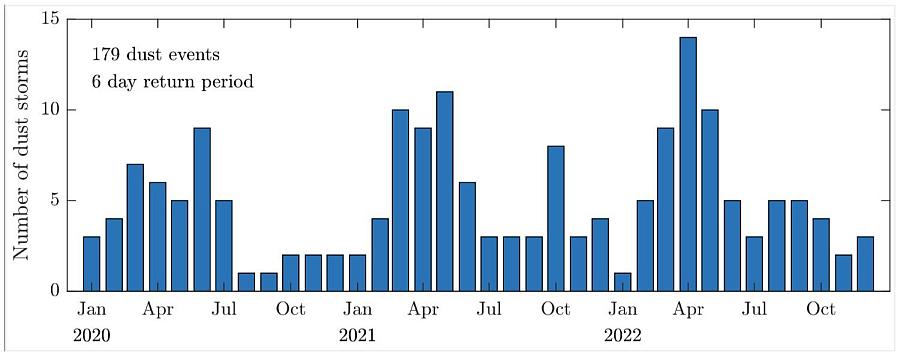
Number of dust storms in the Salton Sea area, January 2020 – December 2022.
(Chart by Alex Kuwano and Amato Evan)
Most of the winter and spring dust comes from the west, where the Anza Borrego desert stretches up to the western shore of Salton Sea, Evan says. Dust plumes billow up behind off-road vehicles, which are popular in the area. But it’s the wild swings in temperature that fuel winds over arid land. In October 2022, a 3,000-foot-high wall of dust from a thunderstorm-driven haboob blanketed the region from Salton City to Palm Springs. It hit the top of the AQI scale at 500—a number that’s considered hazardous for all people.
There are no EPA regulatory air quality monitors in the region, but agencies, tribes, and local community groups have monitors sprinkled throughout the region. Of the 2022 data available, “last year was exceptionally dusty,” says William Porter, a U.C. Riverside environmental scientist. In 2015, a community-university partnership established a network of 40 air quality monitors, dubbed the Identifying Violations Affecting Neighborhoods, or IVAN network, in Imperial County. The IVAN data reveals that last year had some of the highest recordings of PM10, or fine particulate matter. Over half of the highest 50 daily IVAN PM10 recordings occurred after January 2022.
The state’s most visible dust mitigation project is in Salton City, where over 300,000 hay bales have been placed on the dry sandy shores that surround the sea. Elvira Herrera, an organizer for the farmworker advocacy organization Lideres Campesinas and a resident of Salton City, thinks the bales have made little difference. But state officials in charge of the project say otherwise. At a July 13 webinar, Steven Garcia, senior engineer at the California Department of Water Resources, says that dust emissions from the hay bale site are down roughly 90 percent compared to last year.
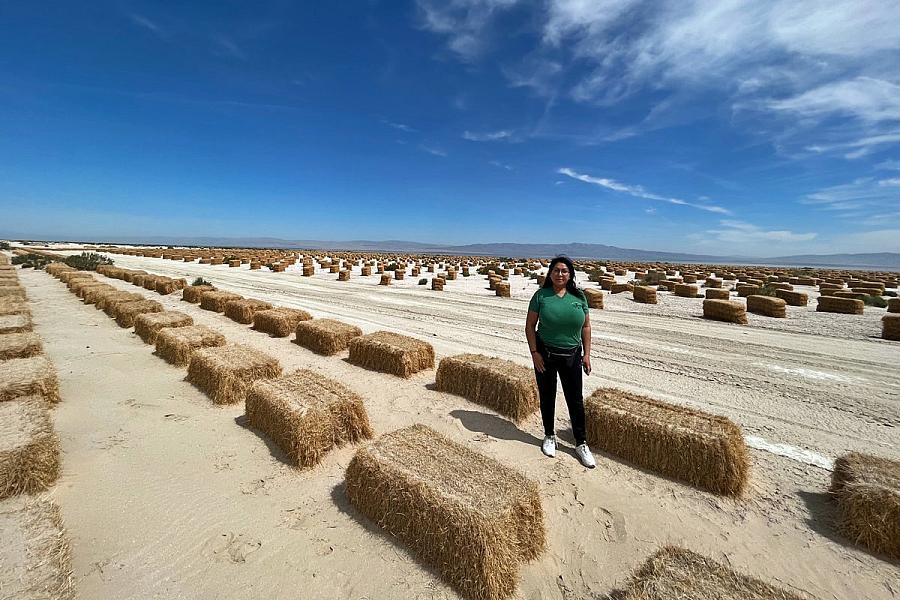
Elvira Herrera stands on the shore of the Salton Sea, where 300,000 hay bales have been placed to mitigate dust.
(Photo credit: Virginia Gewin)
But, scientists say, the goal of the hay bales and other dust mitigation projects is simply to prevent playa dust from making poor air quality worse.
“If the emissions aren’t from the shoreline, no amount of straw bales is going to improve the air quality,” says John Gillies, an atmospheric physicist at the Desert Research Institute in Reno, Nevada.
“The dirty secret is that people are being impacted by agricultural and desert lands much more than the Salton Sea playa,” says Earl Withycombe, retired air resources engineer with the California Air Resources Board. But, he cautions, “that will change over time.” In Imperial County, most of the PM2.5 emissions come from agricultural lands, pasturelands, and unpaved roads. But, Withycombe adds, agricultural sources are not being studied, evaluated, or regulated in any decent fashion.
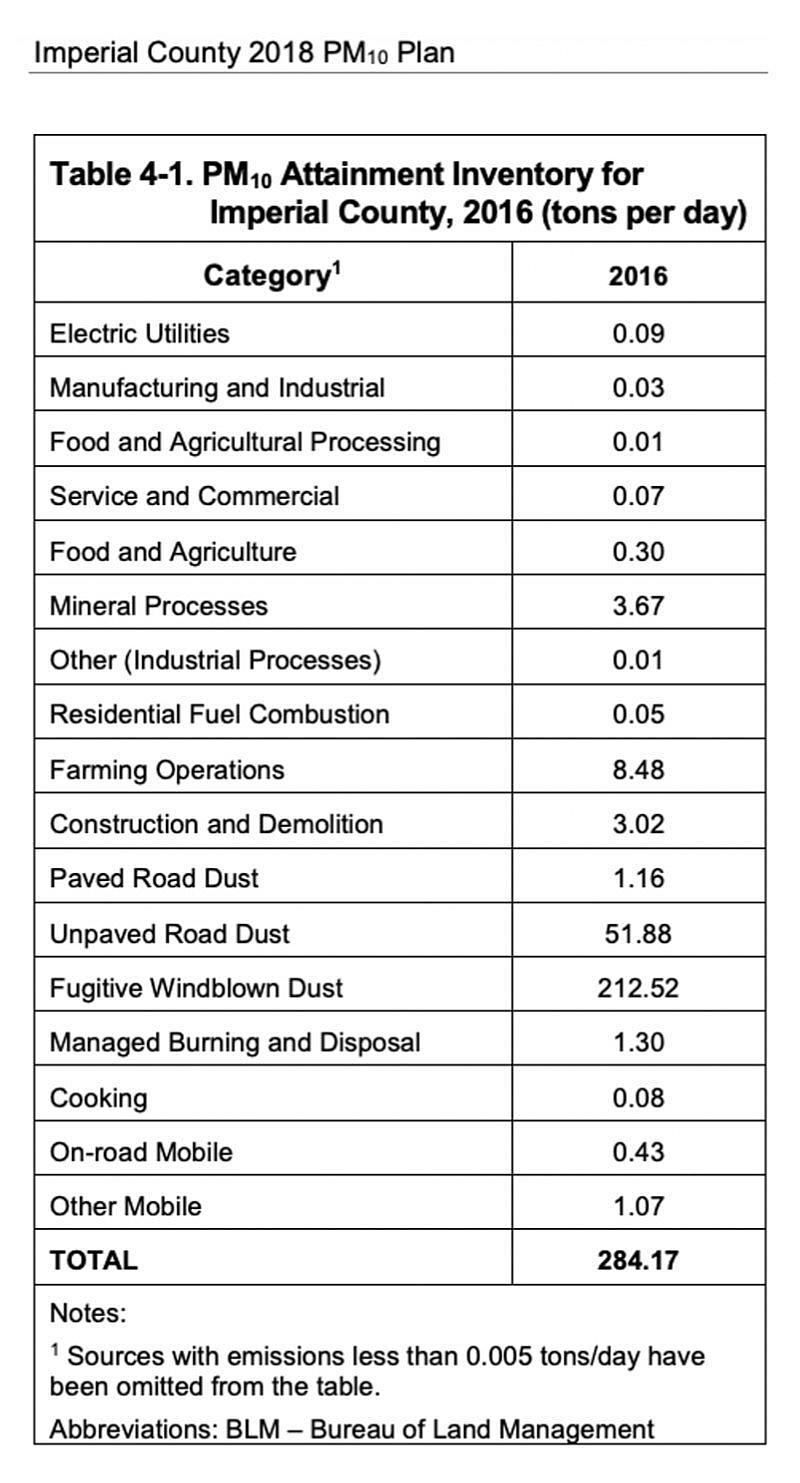
Data showing the sources of PM10 pollution in the Imperial Valley.
(Source: Imperial County Air Pollution Control District)
The exposed playa area, however, is expected to double—to over 60,000 acres—by 2028. And as more playa is exposed, more of the pollutants those sediments contain could enter the air.
Environmental monitoring for toxins in the exposed playa has been minimal over the last two decades—despite continued calls for more. The Imperial County Air Pollution Control District (ICAPCD) says characterizing any sediment or dust contaminants would likely cost millions, and that’s money they don’t have. “We are agencies that are subject to the pull and push of the legislature . . . . and we only have so much manpower. And, quite frankly, it’s expensive,” says Monica Soucier, a division manager at ICAPCD.
While ICAPCD has spent just under $2 million to improve school air filtration systems and $580,000 for urban greening projects, they have not provided community members with affordable access to home air purifiers as has been done in wildfire-impacted counties, although they are exploring the option.
The lack of coordination between agencies overseeing dust mitigation, wildlife habitat restoration, water quality, air quality, and public health is a source of frustration in the communities around the sea. “Even if every agency [involved in the SSMP] did everything it was supposed to be doing, it still wouldn’t begin to address all the [air quality] problems in the area,” says Michael Cohen, a senior researcher at the Pacific Institute, which provides independent environmental policy analysis.
‘A Soup of Microbial Material in the Water’
On a Saturday in April, Daniel Ramirez, born and raised in Oasis, a small community on the north shore of the sea, huddled under a canopy to measure nitrate and sulfate levels collected from various points around the Salton Sea. He is one of 10 community scientists who volunteer every other month to track the sea’s water quality. “I suffered from asthma as a kid,” he says, and that experience has motivated him to explore the links between water and air quality in the region. Whatever is in the water can end up in the air he and his family breathes, he says. The team posts the data online so it is accessible to the public.

Daniel Ramirez and other community scientists volunteer to track the Salton Sea’s water quality every other month.
(Photo credit: Virginia Gewin)
Several of the volunteers push the inflatable boat over the salt-encrusted playa and a few wooden planks to launch it in knee-deep muck. The team is organized by Ryan Sinclair, an environmental microbiologist at Loma Linda University, and Alianza, a community organization. They began collecting data in 2020 to fill a gap left after water receded from the sea’s few existing docks and the Bureau of Reclamation stopped taking samples.
“We’re trying to make the connection between water quality and air quality,” says Aydee Palomino, an environmental justice advocate at Alianza. To that end, the team plans to mount a monitor in the sea for hydrogen sulfide, the rotten-egg smelling gas produced when microbes lack oxygen. Their first attempt ended after two days when a small, cheap air sensor became corroded by salt. (The sea is twice as salty as the ocean.)
Like many freshwater bodies in the U.S., the Salton Sea is also suffering from eutrophication, an excess of nutrients, in part from fertilizer runoff, that fuels algal blooms that deplete oxygen. “Everyone has been focused on the accumulation of salt, but the nutrients are arguably the bigger problem,” says Caroline Hung, a Ph.D student who has been taking cores of Salton Sea sediment for the last three years.
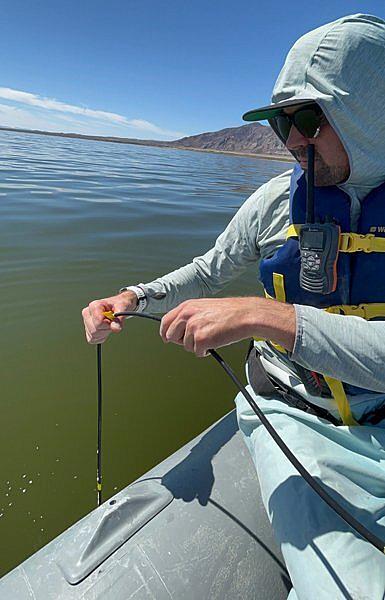
Quinn Montgomery takes a water sample from the Salton Sea.
(Photo credit: Virginia Gewin)
“Water quality appears to be decreasing,” said Sinclair in the California Water Resources Board meeting in May. “Water quality isn’t just water quality. It’s associated with air quality, ecology, and biologicals in the lake. We need to look at this in terms of public health,” he added.
At the same meeting, Tim Lyons, a biogeochemist at the University of California, Riverside, laid out the elevated levels of selenium, molybdenum, and nutrients—and what he sees as the biggest hurdle. “This is not just a money problem,” he said. Rather, he expressed frustration at the lack of coordination across so many state agencies. He likened the Salton Sea discussions to a monster with 20 heads. “Half of those heads are eating each other and the other half aren’t talking to each other.”
For example, long after the vast majority of fish have died, the state has just started drafting a document with total maximum daily loads (TMDL) for nutrients. But it will likely be years before regulators start working with farm owners in the area to ensure they release fewer nutrients in the water running off their land. TMDLs are needed to stabilize the sea’s water quality, says Michael Stenstrom, a professor of environmental engineering at University of California, Los Angeles. “It’s going to be so expensive, and there’s so much resistance to the kinds of things that are needed to fix it, I wonder if they’re ever going to happen,” he says.
Farmers will surely fight it, as restricting fertilizer use often involves systemic changes such as reduced tillage, cover crops, and other costly practices that focus on soil health.
The sea’s microbes are also likely contributing more to poor air quality than previously understood. New science shows that airborne algae and harmful toxins produced in oxygen-free, nutrient-rich waters are a growing concern.
Last year, David Lo, director of the Center for Health Disparities Research at University of California, Riverside, published startling findings suggesting that Salton Sea residents’ symptoms could be a different type of asthma. Mice exposed to Salton Sea dust experienced lung inflammation, but it wasn’t the allergic response common to asthma. Instead, exposure resulted in a greater numbers of neutrophils—the cells that make up the first line of immune defense against invading pathogens. Lo’s working hypothesis is that biological toxicity from the dust may be a key trigger.

Nancy Del Castillo and Mary Bautista (left) discuss a study about the health conditions of children living near the Salton Sea. The study included several photos from local residents, who shared images of their rashy skin and medication used to treat allergies, asthma, and other health conditions.
(Photo credit: Virginia Gewin)
“We have a soup of microbial material in the water,” said Lo, while presenting his research at the Salton Sea Authority Board meeting in March 2023. “We are interested in whether that material is pulled into playa, and into dust,” he added. To identify which communities are most severely affected by particulate matter, Lo wants to conduct a detailed epidemiology study to document specific symptoms, as well as winds and environmental conditions. But funding has yet to come through.
And Colorado River water cuts are not going to help matters. The Imperial Irrigation District, the largest and arguably most powerful one in the nation, has used the ongoing concerns over rising Salton Sea dust to keep a hold on precious Colorado River water for years. In November 2022, the Imperial Irrigation District agreed to conserve up to 250,000 acre-feet of water per year—in exchange for $250 million in federal funds and indemnification against any liabilities arising from potential environmental and public health impacts from the cuts.
What Will it Take to Spur Change?
“Agriculture is the backbone of industry in Imperial County,” wrote county supervisor chairman Michael Kelly in a 2021 crop report touting agriculture’s $4 billion contribution to the local economy in 2019. Yet over 30 percent of the children in the county live in poverty.
“I don’t know of any community benefits from the ag industry,” says Luis Olmedo, executive director of Comite Civico del Valle Inc., a community advocacy organization based in Brawley, California. He cites the lack of unions or profit-sharing models. “If we are going to be eating the waste or contaminants in our environment, we need to have a return,” he adds.
“We’ve always said that if the Salton Sea was [in] San Francisco, Sacramento, or Los Angeles, the problems would have been solved long ago.”
Although the Imperial Irrigation District rigorously models only desert and playa dust emissions, farm soils in this wind-prone region are routinely disturbed. Agriculture’s contribution to air quality is dominated by wind-blown dust, says Withycombe, the former California Air Resources Board member. The existing rules and regulations for dust mitigation plans from agricultural lands—if properly enforced—would further reduce emissions to some extent. “That would result in the biggest improvement in air quality in my opinion,” says Withycombe.
Adoption of conservation practices in the region is quite low. Of the almost 540,000 acres in production in Imperial County, less than 10 percent, or just under 46,000, are organic. And the 2017 USDA census data indicate that only 5 percent of farmers practice no-till, which disturbs the land the least, and 1 percent use cover crops.
The eastern Coachella Valley AB-617 community is also working to tackle pesticide use concerns. It’s “a courageous decision because emissions of pesticides are controlled by the Department of Pesticide Regulation, which has historically been very supportive of the industry it governs, agriculture,” explains Withycombe. As a result of residents’ advocacy, the state is overseeing a review of three different fumigant pesticides used in the region.
And Withycombe agrees with Sinclair that more effort is needed to determine the exact public health impacts from the nutrient-saturated sea. In February, Ramirez, Sinclair, and others wrote a letter to the Colorado River Basin Regional Water Quality Control Board urging the establishment of total maximum daily loads to improve public health and air quality.
In the near term, Porter is teaching residents how to make their own low-cost air filters using box fans. Until now, Withycombe adds, air pollution control districts have focused on reducing emission sources rather than providing air filtration equipment. “But given what we know,” he says, “it would be a good investment at this time to improve [community] health.”
Cohen has been working on the Salton Sea, and with the marginalized communities that live around it, for roughly 25 years. He is relieved to see dust suppression projects finally being built, but he says the region is going to need much more to improve environmental conditions. “We’ve always said that if the Salton Sea was [in] San Francisco, Sacramento, or Los Angeles, the problems would have been solved long ago,” he says.
